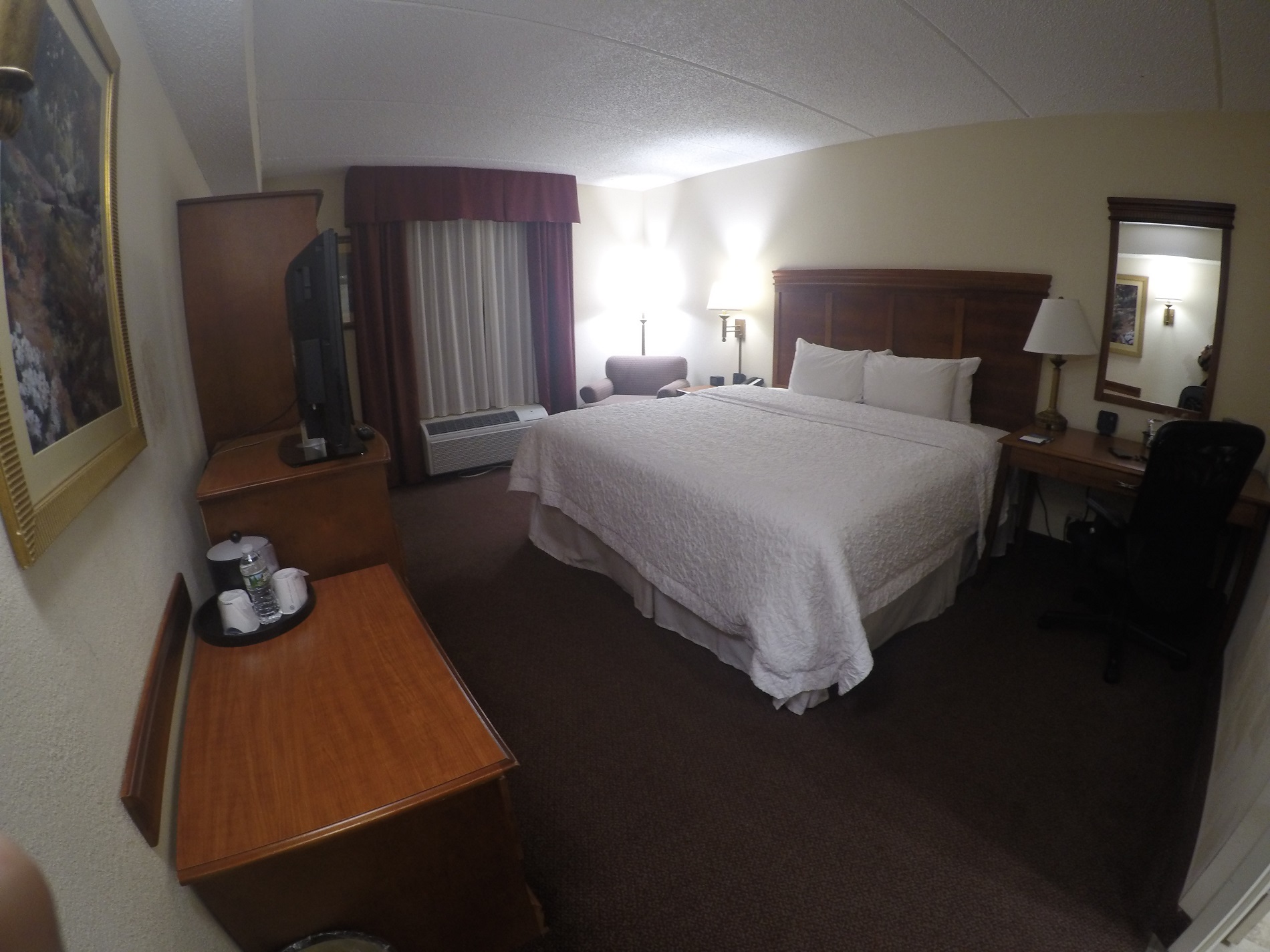NOTICE: This post references card features that have changed, expired, or are not currently available
With “new” versions of both Marriott Rewards and Hilton Honors rolling out this year, somewhat following in the footsteps of last year’s World of Hyatt launch, you might find yourself wondering this: moving forward, which hotel loyalty program is the most rewarding? I found that question wasn’t easy to answer, and it only developed more layers as I delved into it. In the end, I think beauty is in the eye of the beholder — but here’s a look at some comparisons that might help you judge for yourself. In this post, I will be focusing on a comparison between Marriott, Hyatt, and Hilton. In a future post, I’ll take a look at IHG, Radisson Rewards, Wyndham, and Choice.

Note: We are comparing to the “new” Marriott
Quick note here — for the purposes of comparison, I’ll be using the “new” Marriott program even though it doesn’t launch as such until August 1st. You can read all about the transition in our Marriott SPG Ritz Transition Guide.
Earnings: Base, “Free breakfast”, and Top Tier
For starters, let’s look at the basic earning structure at three key status levels for each of these three hotel programs. In the chart below, “base” refers to the base level where all members begin at Stay #1. Since a key status benefit for many people is free breakfast, the next status level is dubbed “Free breakfast” and considers the lowest status level that qualifies for free breakfast: Marriott Platinum (50-night), Hyatt Explorist (a stretch here as you don’t get free breakfast on every stay but rather 4 club lounge upgrades per year, so this status level isn’t exactly comparable), and Hilton Gold. Here are the earning rates in points per dollar:
| Status | Marriott | Hyatt | Hilton |
| Base | 10 | 5 | 10 |
| “Free breakfast” | 15 | 6 | 18 |
| Top tier | 17.5 | 6.5 | 20 |
Average cost of a hotel room: $131.56

According to Statista.com, the average daily rate of hotels in the US as of March 2018 was $131.56. I have no idea how reliable Statista is, but for the purposes of comparison, we really just need a number, and this one will work as well as any.
Nightly earnings based on an average night
Next, we look at how many points you would earn per paid night based on the average nightly cost of rooms in the US noted above. Your cost could of course increase or decrease and so too will your points with the price you’re paying. For the purposes of comparison, let’s assume no promotions. Your earnings on an average night based on the $131.56 figure from Statista would be as follows:
| Status | Marriott | Hyatt | Hilton |
| Base | 1,315.6 | 657.8 | 1,315.6 |
| “Free breakfast” | 1,973.4 | 789.4 | 2,368 |
| Top Tier | 2,302.3 | 855.1 | 2,631.20 |
Points earned en route to status
Let’s next look at how many points you would earn on your way to status. This chart shows the number of points you would earn based on the minimum number of nights needed to achieve each of the three status levels being used for comparison assuming the average nightly US hotel rate numbers above.
These numbers get a little complex and some of the more intricate math is left out of the chart. For example, with Marriott, you would achieve Gold status after 25 nights and begin earning a 25% bonus on points on night #26 — meaning that the next 25 nights en route to “free breakfast” status earn a 25% premium on top of the base earning of 1,315.6 per night. Then we have a 50% bonus at Platinum (50-night) and there is another tier at Platinum Premier Elite 75 before Platinum Premier Elite 100 at the top (though here we are ignoring the $20K spend requirement for Platinum 100, which you wouldn’t reach based on an average nightly cost of $131.56). The numbers below consider the total points earned en route to the minimum qualification standards at each level including those premiums for status. Note that Hilton allows members to qualify on nights or stays. For the purposes of a bare-bones comparison, I assumed you would meet the stay requirement with 1-night stays.
| Status | Marriott | Hyatt | Hilton |
| Base | 1,315.6 | 657.8 | 1,315.6 |
| “Free breakfast” | 74,000 | 19,734 | 30,522 |
| Top Tier | 180,895 | 44,730.4 | 54,203 |
Based on that chart, Marriott looks to be far and away the most rewarding in terms of sheer points. However, this chart is a bit misleading since Marriott requires more nights at each level (Marriott requires 50 for free breakfast (Platinum status) vs 30 for Hyatt Explorist or 20 for Hilton Gold; Marriott requires 100 for top tier Platinum 100 vs 60 for Hyatt Globalist or 30 for Hilton Diamond if you do 1-night stays). This is far from an apples-to-apples comparison — though one takeaway is that those earning top-tier Marriott status will have a large stash of points when they get there.
Number of average paid nights necessary to earn a Level 1 free room

Next let’s consider the number of paid nights that would be required based on the $131.56 average US hotel room cost in order to earn a free Level 1 night in each program. As a reminder, standard Category 1 awards are priced as follows:
- Marriott = 7,500 points
- Hyatt = 5,000 points
- Hilton = Technically 5,000 points, but the lowest in the US appears to be 10,000 so we’ll use 10K for comparison
Referring back to the nightly earnings based on the cost of an average night in the US, you would need to stay the following number of nights in each program to earn a free “level 1” hotel night (rounded up to the next full night):
- Marriott: 6
- Hyatt: 8
- Hilton: 7*
Hilton gets an asterisk because, based on qualifying for Silver status after 4 one-night stays, you would earn 9,996.16 points based on our average rate after 7 nights — less than 4 Hilton points shy of the total necessary for a free night. While I rounded Marriott and Hilton up to the next full night, it seemed unfair to round Hilton up when charging an extra $0.40 to your room would get you the points needed for that free night.
Overall, this metric kind of surprised me. Without having run the numbers, I wouldn’t have expected that all three chains were so close to even. Of course, things are relative here. In 2019, Marriott will introduce peak and off-peak pricing, at which point it will require about 8 “average” paid nights to earn a free Category 1 peak night — though it will only take 4 average paid nights to earn enough points for an off-peak level 1 night. Also important to consider is the fact that Hilton has dynamic pricing, so you can’t count on a property to always charge 10K per night. On the flip side, if you travel to the international destinations with 5K properties, you could earn free nights even faster.
I have to admit, I was pretty surprised that Hyatt is lagging behind, even if only slightly, at Category 1.
Number of nights needed per top-tier free room

On the other end of the spectrum, if you are a road warrior spending many of your nights away from home in hotels, you might be most interested in using the points you have earned to stay in paradise at a property where you wouldn’t otherwise consider paying the cash rate. A free night in a standard room at a top-tier property will set you back the following quantities of points:
- Marriott: 60,000 points
- Hyatt: 30,000 points
- Hilton: 95,000 points
Based on the average nightly US hotel rate of $131.56 and the base earning structures above (i.e. with no status), you would have to spend the following number of “average” $131 nights to earn the points required for a night at each chain’s top-tier properties:
- Marriott: 46 nights
- Hyatt: 46 nights
- Hilton: 73 nights
However, those numbers aren’t really accurate. In each of the programs above, you would achieve some level of status en route to those quanities of nights and with that status comes more points-per-night.
For example, the new Marriott program will award new Gold status after 25 nights, which will include a 25% bonus on points. In other words, the first 25 nights would earn 10 points per dollar — but then you would earn 12.5 points per dollar on the next 25 nights.
To give an example, let’s look at how this works out with Marriott:
- The first 25 nights earn 1,315.6 points per night (32,890 points)
- At that point, each night earns a 25% bonus — or 1,644.5 points per night keeping the same average cost per night
Since a top-tier night requires 60,000 points, we can subtract the 32,890 points earned from the first 25 nights and find that we would need an additional 27,110 points for a free top-tier night.
- 60,000 points needed – 32,980 points earned in first 25 nights en route to Gold status = 27,110 points to go for a top-tier room
We can next divide that total by our 1,644.50 points earned per night with Gold status to find that we would need another 16.4 nights — which we’ll round up to 17 nights since we can’t spend four-tenths of a night. In other words, earning enough points for a free top tier (60K) night would require:
- 25 nights at the base earning rate + 17 nights at Gold status earning rate = 42 total nights
It would require 42 nights based on an average rate of $131.56 to earn enough points for a free top-tier standard room night. That illustrates the math used for the other numbers below.
Based on status multipliers, it would take the following number of average ($131.56) nights to earn a top-tier free night in each chain:
- Marriott: 42 nights (25 at base, 17 at Gold with 25% bonus)
- Hyatt: 42 nights (10 at base, 20 at Discoverist with 10% bonus, 12 at Explorist with 20% bonus)
- Hilton: 42 nights (4 at base, 16 at Silver with 20% bonus, 10 at Gold with 80% bonus, 12 at Diamond with 100% bonus plus 10,000 bonus points after 40 nights)
This I couldn’t beleive. I had to run the numbers a couple of times and check the math – though I guess I shouldn’t be so surprised that the corporate bean counters have come to the same figure while being paid to create three wildly different and complex equations to get there. Hilton may yet be a bit misleading because it is working under the expectation that the first 30 nights are done as 1-night stays in order to qualify for Diamond status in the fewest number of nights possible. That may not be realistic for most people, so it would actually require more stays for a free top-tier night. On the other hand, you could start with Diamond status straight out of the gate with the Aspire card and earn 14 points per dollar on your paid Hilton rates with that card . . . which brings me to the next step….
Using the credit card to pay for nights

The Marriott cards that currently exist will earn as many as 6x points at Marriott properties (an additional 789.36 points per night based on our average figure used above). The Hyatt credit card earns 3x at Hyatt properties (an additional 394.68 points per night). The Hilton cards earn as much as 14x at Hilton properties (an additional 1,841.84 points per night). The point of this post isn’t to compare credit cards, but rather to determine which loyalty program is the most rewarding. But the key takeaway here is that these points earned from the hotel cards can help you get to a free night even faster.
So which program is the most rewarding?
As you can see above from the math above, this is a hard question to answer. In terms of earning award nights at the least expensive categories, Marriott has a very slight edge from the beginning. However, if you achieve top-tier status, that edge becomes negligible. In fact, with Hilton Diamond status possible straight out of the gate, many peope could start out earning 34 total Hilton points per dollar on paid stays from Day 1 (20 from Diamond status and 14 from the Hilton Aspire card), which would make a sizable difference in the numbers — instead of earning 1,315.6 points from that $131.56 average rate, you could earn 4,473.04 points. That would mean earning a Level 1 free night after every 3 paid stays and a free top-tier night after just 22 nights based on those average numbers. That sure does make Hilton an attractive option, even without considering the strong value proposition on the Aspire card in terms of its cost vs benefits (See: A new ultra-premium card, in-depth review: Amex Hilton Aspire for more on that card).
Of course, a key part of the Hyatt picture for many readers is the ease which which Hyatt points can be accumulated in the form of Chase Ultimate Rewards points. The same could be said for Marriott Rewards points. Indeed, the ease with which you can earn the points via ancillary methods is of importance.
Others will choose brand loyalty based on the aspirational properties within a portfolio, and it becomes hard to compare programs based on their top-tier properties since redemptions are so personal — though I think Marriott’s portfolio, with its newly expanded luxury properties from SPG and Ritz that will make their way into the 60K category (at least initially) might provide more bang for the buck in terms of earning free nights at hotels that cost the most money. But when the new Category 8 debuts in 2019, along with peak pricing, it will require even more paid nights to earn free nights at those top-tier properties.
However, in 2018, the battle is closer than I may have expected in terms of reward for your nightly room spend, with very little difference at the low end or high end of the award charts. With return on your hotel spend being near equal, it would be hard to consider Hyatt the most rewarding since they require more nights for true free breakfast (Globalist status) than either Marriott (50 nights) or Hilton (20 nights). If we add a Hilton Aspire card into the mix, I think it would be hard to ignore the earning power in Hilton Honors. Though, to be fair, Marriott offers an actual award chart, with plenty of potentially valuable categories. That might make it feel like a safer bet than Hilton’s program as it will provide more opportunities for outsized value.
In the end, I don’t think there is one clear winner for everyone, rather it will depend on your goals. Those who are looking for the biggest point earnings will look to Hilton and plan to get the Aspire. Those who are looking to earn nights at more valuable properties might choose Marriott. Surprisingly, I find Hyatt to be the odd man out — neither offering the chance to rack up more free nights than competitors at either end of the spectrum. When we further consider Hyatt’s extremely limited footprint comparatively, I think it’s much easier to determine a loser in this battle. That’s not to say that I don’t like Hyatt — and in fact I will be happy to transfer Ultimate Rewards points to Hyatt (or a Globalist friend) for the right redemptions, but I remain surprised that Hyatt has not enhanced its earning structure to try to take a lead on its much bigger competitors.
I look forward to using my Marriott points for some great properties when the new award charts debut, but I think my hotel loyalty leans towards Hilton in this round.
What do you think? Which of these hotel loyalty programs is the most rewarding?





[…] but Hilton’s award pricing vexes and perplexes me at times. I’ve previously showed that their program is reasonably rewarding (Greg’s take was a bit different than mine) and then Greg ran the math on how […]
[…] regards to the cost per night, I’ve gone with $131.56. That’s the figure Nick used for his posts about which hotel loyalty program in general was the most […]
[…] regards to the cost per night, I’ve gone with $131.56. That’s the figure Nick used for his posts about which hotel loyalty program in general was the most […]
One of the reasons I prefer Hyatt over Hilton, is simply the cost of points per room redemption. As someone who does not have a hotel credit card, my points go a lot further at Hyatt than at Hilton. For example, a recent trip to Waikiki showed that Hilton hotels were charging 50k a night, most were even higher. Hyatt was charging 12k. So for someone transferring Chase Sapphire points, it made far more sense to use Hyatt. We were able to stay for four nights at Hyatt for the cost of the lowest end one night Hilton redemption cost. However, the low footprint of Hyatt has hampered us considerably. There are no Hyatt’s in Branson, MO (where we had our wedding redemption) or in many well known cities in Europe.
[…] developed more layers as I delved into it. I started by comparing Hilton, Hyatt, and Marriott (See: Which hotel program is the most rewarding? Hyatt vs Hilton vs Marriott). In that post, I promised to follow up with a few other programs. In the end, I think beauty is in […]
Depends where you have status and your preference, perhaps a good or bad experience may weigh in. Marriott will usually also give you a perk, either free drink or snack. At one of the Fairfield’s, they gave 2 tokens for either beer or wine.
[…] have recently been looking at which hotel loyalty schemes offer the best return on paid stays (see here and […]
[…] presented our different takes on which hotel chain (Hyatt, Hilton, or Marriott) was most rewarding (here and here). We looked at how much you’d have to stay at those hotels in order to earn free […]
I´m not sure when I last saw a 10k points redemption for Hilton in the US, but… it´s been a long time ago. Nowadays you got to be happy, flexible as to when you book and be willing to sleep in a run down Hampton Inn somewhere 20mi outside of the city to even get a 20k redemption. And top tier redemptions are – in fact – more often around 200 something thousand points with Hilton.
[…] and I explored which hotel programs are the most rewarding between Hyatt, Hilton, and Marriott. In my analysis, I looked at how many “average” priced nights you have to stay at a Hilton to earn […]
[…] Nick published a thoughtful post: Which hotel program (Hyatt vs Hilton vs Marriott) is the most rewarding? His answer was that they’re about the same: If starting from scratch (elite-wise), you need […]
Thanks for the great work. It is insightful, data-driven analyses like these that set you guys apart from the other travel bloggers. Love it!
Phew–who would have thought it would be so complicated. Thank you! I really like they Hyatt points+pay and seem to find pretty good value with those-I long ago dumped Hilton as the majority (lol, at least the ones I was staying at) seemed tired. I have enjoyed my prior stays using Sheraton lounges. Never been to many Marriotts. On a side note–have you or Greg discussed the SPG card, and I missed it? I’ve been using my personal SPG card for regular spend (non restaurant etc) but with the changes upcoming I’m thinking of dumping the card and getting something else. Any recommendations–or am I being overly harsh?
I agree with Christian, for most people and based on the rest of the analysis (that takes into account earnings and status over a fairly long period of time), the Marriott analysis should be based on 2019 and future redemptions, not the brief 5 month window in 2018 that is an anomaly in their program. You could even use the current charts from the programs, which would put the maximum at 105,000. It seems pretty apparent that a room that goes for 105,000 now and 100,000 next year should not really be analyzed as if it costs only 60,000.
Thanks for the hard work on this. I think the other key variable here is quarterly promotions. Hilton double points makes it easy to rack up enough for a free night pretty quickly, while Marriott’s small bonus per Stay this quarter looks pretty weak. On the other hand, mega bonus last quarter was great for lots of short stays. Just another factor to think about that complicated the strick stay equation.